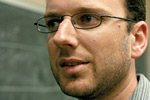From the editor: Challenges
Particle physics has been confronted with serious challenges in recent years, especially for the operation of colliders. Yet 2006 promises to be a great year for research in particle physics as well as photon science, and many exciting projects are underway.
 |
The particle colliders that had experienced difficulties in recent years have recovered, due to the resilience and ingenuity of the physics community. The BaBar experiment at SLAC is seeing record numbers of collisions after rebounding from a shutdown due to an accident. The Tevatron at Fermilab has set numerous records for luminosity, having overcome prior machine difficulties. The HERA collider at DESY in Germany progressed to reach its best performance ever. The RHIC collider at Brookhaven will see many more weeks of operation than expected as a private group of funders is making up for reductions in federal funding. Meanwhile, the Large Hadron Collider under construction in Switzerland is coming ever-closer to completion, after some stumbles along the way.
While existing facilities are now running superbly well, more particle physics is coming. Plans for the International Linear Collider are advancing rapidly with a Reference Design Report anticipated for the end of the year. Many facilities are upgrading, including the Beijing Spectrometer at the Institute for High Energy Physics in China. Neutrino physics, astroparticle physics, theory groups: all expect great advances.
Light sources are also moving rapidly toward a new generation of machines. SLAC's Linac Coherent Light Source, the world's first hard x-ray free electron laser, is about to begin construction for operation in 2009. DESY's VUV Free Electron Laser is operating, and the lab expects to have an X-ray Free Electron Laser in 2012.
We will cover many of these topics in symmetry this year, along with much else. Also look to INFN's new Italian-language magazine Asimmetrie, which we warmly welcome to the stable of lab publications. Although symmetry is published by two US institutions, the health and future of our field is closely tied to the successes of all laboratories and university groups around the world. The “Brighter future” article in this issue might only discuss collider luminosity but the sentiment of the title applies well to the entirety of our field.
David Harris
Editor-in-Chief
Click here to download the pdf version of this article.


